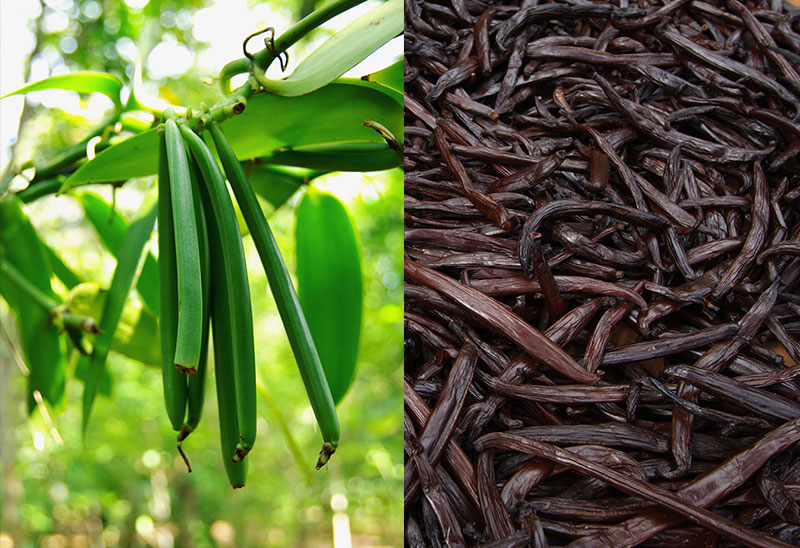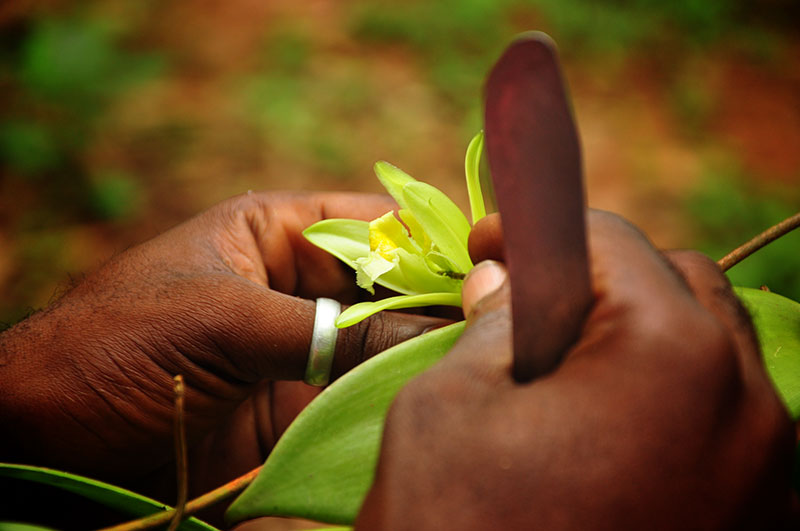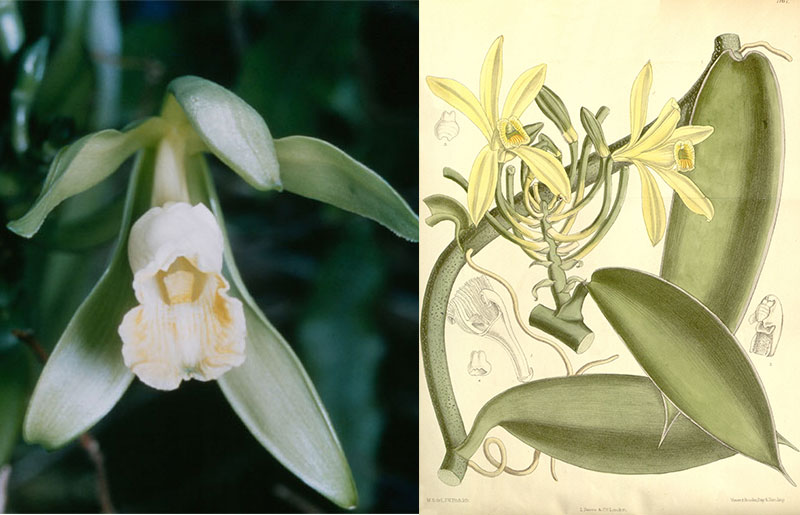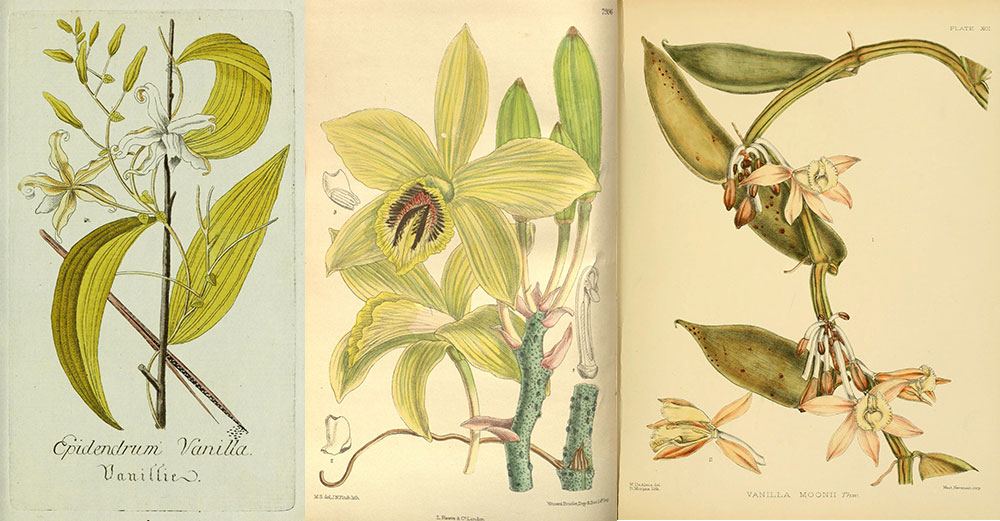Did Montezuma II, the legendary king of the Aztecs, really imbibe 50 cups of a special thick chocolate-vanilla-honey potion every day? We will never know, but we know for sure that vanilla flavoring in any of its many forms is one of the substances that people just cannot get enough of. It can be found in more obvious places like ice cream, cakes, liqueurs, perfumes, tobaccos, and soaps. It is an open secret that Coca-Cola and Pepsi-Cola buy the naturally produced substance in large amounts.
But vanilla flavoring is also where you may not expect it — such as in cough and cold preparations or pet food, where the cheaper, artificially produced substance helps to mask undesirable tastes. It makes most mouths water, which explains why it is also used as a supplement for fodder. Vanilla used to be extolled for its alleged aphrodisiac properties. Curiously, Chandler Burr, one of the world’s most renowned cologne critics, sees vanilla eternally associated with the oldest profession. “Men love vanilla, which is why whores the world over smell like it,” he told me recently. He didn’t tell my why women love it, too, though.
Vanilla planifolia, the most commonly grown species, is a creeping plant and part of the large orchid family. In fact, it’s the only orchid that contributes to human nutrition. Its fleshy, fragrant flowers sport a mix of yellow and green. Many questions remain as far as the exact reproductive biology of the vanilla species is concerned. This is not just a scientific issue, but essential to know in order to create conservation guidelines for some of the genus’s endangered species.

There is a misconception about fermented vanilla. Contrary to common opinion, it isn’t yellow in color: it’s simply because ice cream or cake that contains vanilla often contains egg yolk or a colorant like carotene. Remember the slim, dark sticks or pods in long glasses that don’t look so much like “beans,” but are nevertheless called this? Or the little black seeds in ice cream or baked goods? Nowadays, natural vanilla is mostly sold as a concentrate because it’s much easier to use that way. It counts as the second most expensive spice in the world after saffron.
What adds to the mystery of vanilla is that it’s often associated with dreamy, tropical places in the Indian Ocean like Réunion, Madagascar, and Mauritius. It is native to south-eastern Mesoamerica, though, where the plant used to be pollinated by hummingbirds and native bees. For about 100 years, from the second half of the 18th century on, the Totonac of the Papantla region in the state of Veracruz were the only vanilla exporters in the world. Back then, how pollination took place still presented a big enigma. It was only around 1836 that botanists figured out how to do it artificially: via hand pollination. From that turning point, it was possible to grow orchids in other parts of the world where the natural pollinators didn’t exist. Reunion in the Indian Ocean (back then called “Bourbon,” hence the term for vanilla) soon produced its own vanilla. Mexico lost its monopoly on vanilla production in 1846. The irony is that artificial pollination is now common even in Mexico, because it yields more beans. There, vanilla often grows on orange trees or near coffee bushes. Today, real vanilla mostly comes from Madagascar, but it’s also grown in South China, Indonesia, Uganda, Brazil, and a number of other islands and places like Tahiti. Tim Ecott, the author of Vanilla: Travels in Search of the Luscious Substance has traveled the world to see the main locales where the plant is grown and describes the labor-intensive process of hand pollination. He also gives an impression of the complex build of the flower of the vanilla orchid:
In a small plantation on the edge of Hurepiti Bay (French Polynesia), I pollinated my first vanilla orchid. The little flower was just one of a hundred blooming that morning and it would scarcely matter if I failed. Even so, it was an effort to keep my hand steady as I reached out to take the slender central petal. The finely serrated lip quivered between my thumb and forefinger. I pulled back the tissue, tearing the thin material to reveal the tip of the column inside, the whole structure slightly narrower than the rubber on the end of a pencil. Holding the remains on the lip under my left thumb I could finally see the organs that had rested within its shelter. There, at the tip of the column was the tiny bright yellow ball of pollen hanging from the bulging hood of the anther.
Now, very gently, for the operation.
I had a toothpick-sized splinter in my right hand and I held it under the little flap that drooped over the stigma. With a minute upwards motion I raised the flap just a couple of millimetres, and pressed the anther with its yellow load down onto the upper surface of the exposed stigma.
It was a soundless act, a physical union in which I held my breath.

Once the beans have been harvested, when they are still of yellow color, not fully ripened and closed, resembling thick fat pole beans without any particular flavor, they undergo a complicated procedure and fermentation. They are treated with hot vapor and then dried again. Producers speak of “killing” the bean, which makes them turn smaller and dark brown. One of the biggest challenges is to prevent the bean going moldy in the process. It’s only after several months of storing them in air-tight boxes that they develop their full aroma and shrink to their known size.
The vanilla from each country has its own characteristics. The Madagascan kind produces a creamier, somewhat sweeter flavor than other varieties. Even the soil plays a role. “The quality differences in vanilla can be very subtle. The key factor in the quality is really in the curing process — after all, the species is always the same Vanilla planifolia. Having said that, I found that producers in Tahiti — using Vanilla tahitensis — were making some very nice products and flavoring different alcoholic beverages with their vanilla,” Ecott told me.
Does it always have to be the natural product, or can it be the artificial kind as well? The artificial substance called vanillin was first obtained in 1874 by a German chemist named Gustav Haarmann, who produced it from coniferin, an organic substance found in conifers. Today it is synthesized from rather obscure plant substances or compounds such as eugenol or guaiacol, or from such mundane raw materials such as tar and wood. Vanillin satisfies more than 95 percent of the consumers’ craving of the flavor: The common estimation is that 12,000 tons of the white powder are used every year. Natural vanilla contains close to 500 different chemical substances, of which at least 200 are considered relevant for the particular taste of vanilla, according to Daphna Havkin-Frenkel, who is both a visiting scientist in the Department of Plant Pathology and Biologe at Rutgers University and the Director of Research and Development at Bakto Flavors.

So, for many, it’s not even a choice they have. The particular richness and depth of natural vanilla flavor originates from the chemical complexity of the compounds in vanilla. Just as a table wine is not the same as an elaborate cuvée, natural vanilla cannot be the same as vanillin. But things are moving on. Nowadays, microorganisms, enzymes, and cell culture processes help the fermentation process, and even beyond: “There are very good artificial vanilla flavors, they are expensive as well, however, they are not natural and can not label as such,” says Ms. Havkin-Frenkel. It may be a sobering thought to some, but the benchmark for what constitutes the “right” vanilla taste is not so much whether it has a natural or artificial base, but what forms in the mind of the consumer.
Natural vanilla has been in the news lately. The price of vanilla from Madagascar has doubled after the island experienced a poor harvest. The production of vanilla follows the common logic: When in short supply, prices rise and the farmers have an incentive to plant more. On the other hand, when there is a surplus they may even abandon their vines. As a reaction to the unwelcome price fluctuation, producers began to harvest the beans earlier and put them in vacuum containers in order to be able to use them later when they could sell them at a higher price. The temptation to do so is strong, because after a mere two months they have already reached their maximum length and weight. Since the beans had not ripened sufficiently yet (they require six to eight months) and they had not gone through the usual process, their aroma had not developed yet. Therefore, the quality was inferior. Madagascan authorities then banned the production of beans of inferior quality and the export of unripe beans. The government has burnt hundreds of kilograms of green vanilla. If we picture the 60,000 farmers in Madagascar who grow the plant, we begin to get an idea of the scope of the business. The bad news is that all products relying on natural vanilla, like ice cream and some baked goods, will be more expensive for a while.
A strange footnote. We should remember that, sometimes, “vanilla” doesn’t even have anything to do with the original substance at all: in some Austrian areas, garlic used to be called “the vanilla of the poor man,” as real, authentic vanilla would only have been available to the upper strata of society. And, consequently, the “Vanillerostbraten,” a kind of roast beef peppered with garlic, also carries the name of the noble aroma. •
Images courtesy of hcabral, peter, and Reizigerin via Flickr and John Nugent Fitch, Lukas Hochenleitter und Kompagnie, A.H.G. Alston, et al., Toapel, and Matilda Smith via Wikimedia Commons (Creative Commons)




